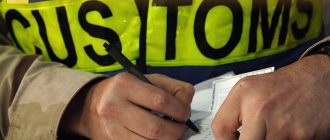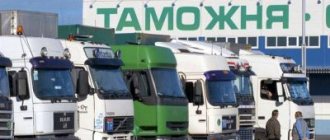Many participants in foreign economic activity believe that once an imported product has crossed the border of the Customs Union and is accepted for accounting, then they can “relax.” However, it is not. Moreover, some companies that do not import goods into Russia on their own and purchase goods on the country’s domestic market do not even suspect that they are facing a customs inspection with the consequences inherent in such audits - fines, penalties and even seizure of goods.
A logical question arises: why is this possible and what legal basis allows customs authorities to “nightmare” companies that, as it seems at first glance, have nothing to do with the customs clearance of goods they purchased in Russia?
The answer to this question is contained in the Customs Code of the Eurasian Economic Union, which entered into force on January 1, 2018. A similar rule was in force previously in the Customs Code of the Customs Union. It is this norm that allows customs officers to carry out inspections within three years after the release of goods into free circulation.
Good faith and fine
It would seem, what attitude do buyers of imported goods of the second or third order have to the illegal import of such products? The whole point is that customs legislation provides for joint liability for payment of payments for such goods - both for those who imported them and for those participating in further resale.
However, the extent of liability of the acquirer of illegally imported goods depends on the details. The key point is whether evidence will be found that the person knew or should have known that the import of such goods was illegal. If the buyer is conscientious and the auditors do not find evidence of illegality, the inspectors either arrest or seize the disputed goods and issue a demand for payment of customs duties and taxes without charging penalties and a requirement for customs declaration (Article 168 of the Federal Law No. 311).
If customs officers discover that the buyer is dishonest, and there is evidence of this, the buyer will be required to pay duties and taxes. In addition, the customs authority has every right to collect penalties and arrears due to such non-payment. In addition, an unscrupulous purchaser faces administrative liability under Article 16.21 of the Code of Administrative Offenses of the Russian Federation.
Let me remind you that, according to the norm, legal entities face a fine in the amount of 50 to 200 percent of the value of illegally imported goods with their possible confiscation.
As a rule, facts of illegal import are revealed during customs inspections. By analogy with tax legislation, customs audits are divided into desk and field audits. Desk inspections are carried out by customs authorities without visiting the person being inspected at their location and consist of analyzing data from declarations and shipping documents. Desk inspections are carried out an unlimited number of times and without formalizing such inspections with decisions.
An on-site customs inspection, as its name suggests, is carried out by inspectors at the location or place of actual activity of a company or individual entrepreneur.
As a rule, an on-site inspection is carried out on the basis of information received by customs officers independently - this is carried out by the analytical departments of customs; Also, on-site inspections are often ordered based on information from other government bodies (for example, the Federal Tax Service) as part of interdepartmental interaction, foreign government bodies, after a desk customs inspection, from banks, as well as from open sources.
Customs declaration of goods
Customs declaration is the submission of a customs declaration to the customs authority. The declaration contains information about the goods, the chosen customs procedure, the method of movement of goods and the conditions of the foreign trade transaction with them, as well as information about customs duties payable.
A customs declaration can be submitted by the declarant, as well as by a customs representative on behalf of and on behalf of the declarant.
What needs to be declared?
All goods imported or exported from the customs territory are subject to customs declaration.
Types of customs declaration
Depending on the declared customs procedure and the person moving the goods, the type of customs declaration is determined:
- goods declaration,
- transit declaration,
- passenger customs declaration,
- declaration for the vehicle.
In foreign trade turnover, when exporting and importing goods, a goods declaration is used. Its form and procedure for filling out are determined by Decision of the Customs Union Commission dated May 20, 2010 No. 257.
In what form can goods be declared?
In accordance with the Customs Code, goods can be declared in both written and electronic form on the territory of the Customs Union.
However, on the territory of the Russian Federation, from January 1, 2014, a requirement for mandatory electronic declaration of goods was introduced. From this date, all documents and information are submitted to the customs authority exclusively in the form of electronic documents. Also, further interaction between the customs inspector and the declarant takes place electronically: they transmit to each other authorized messages signed with electronic signatures.
Decree of the Government of the Russian Federation dated December 13, 2013 No. 1154 provides a list of exceptional cases when goods may be declared in writing. For example, these include:
- declaration of goods, information about which is classified as a state secret;
- declaration of goods placed under customs procedures for destruction or refusal in favor;
- declaration of goods sent by international mail;
- declaration of goods transported by certain categories of foreign persons (diplomats, consuls, etc.);
- declaration of goods illegally imported into the customs territory.
In addition, express cargo and goods whose value is less than 1000 euros in equivalent are allowed to be declared using a simplified procedure - in the form of a written statement or a list of goods (Decision of the Customs Union Commission dated May 20, 2010 No. 263).
Types of checks
Customs legislation distinguishes two types of on-site inspections: scheduled and unscheduled. Scheduled audits are carried out by customs officers based on quarterly plans for preventive inspections approved by the Federal Customs Service of Russia.
Customs legislation does not disclose specific reasons and indicators that influence the inclusion of a company in the verification plan.
The legislator limited himself to only listing the sources of information on the basis of which declarants are included in the check list. Customs officers take into account the results of customs control during declaration, as well as after the release of goods, use their own information bases (for example, KPS “Postcontrol”, “Monitoring-Analysis”), and evaluate the results of previously conducted audits. In addition, customs authorities use information received from banks, the media, customs authorities of EEC member states, as well as the results of previous inspections.
note
Scheduled audits are carried out by customs officers based on quarterly plans for preventive inspections approved by the Federal Customs Service of Russia. Customs legislation does not disclose specific reasons and indicators that influence the inclusion of a company in the verification plan.
It is important to note that the order in which such control activities are carried out has been regulated.
Thus, according to the UES Customs Code, scheduled on-site customs inspections can be carried out no more than once a year in relation to the same company. In relation to authorized economic operators (hereinafter referred to as AEO), this period is even longer - no more than once every three years.
When conducting scheduled on-site inspections, customs is obliged to send the declarant a notification of such an audit by registered mail with notification. The inspection itself can begin only 15 days from the date the company receives this notification. For unscheduled on-site customs inspections there are no restrictions on the frequency of their conduct.
The Customs Code of the Eurasian Economic Union establishes that the reasons for conducting unscheduled inspections may be the customs’ own data, information received from other government agencies about a possible violation of customs legislation, as well as requests from customs and law enforcement agencies of EEC member states.
In addition, the reason for conducting an unscheduled inspection may be the need to conduct a counter on-site customs inspection.
Customs check
Customs inspection is carried out by customs authorities in order to verify compliance by persons with the requirements established by the customs legislation of the customs union and the legislation of the member states of the customs union.
A customs inspection is carried out by the customs authority of a member state of the customs union in relation to inspected entities created and registered in accordance with the legislation of this member state of the customs union.
Inspected persons mean:
1) declarant;
2) customs representative;
3) carrier, including customs carrier;
4) a person who has authority in relation to goods after their release or his representative;
5) the person carrying out temporary storage of goods;
6) owners of duty-free shops, customs and other warehouses;
7) authorized economic operator;
 other persons directly or indirectly involved in transactions with goods placed under the relevant customs procedure;
other persons directly or indirectly involved in transactions with goods placed under the relevant customs procedure;
9) a person in respect of whom there is information that in his possession or use there are (were) goods in violation of the procedure provided for by the customs code of the customs union, including those illegally transported across the customs border.
During customs inspection, customs authorities check:
1) the fact of placing goods under the customs procedure;
2) the reliability of the information stated in the customs declaration and other documents presented during the customs declaration of goods that influenced the decision to release the goods;
3) compliance with restrictions on the use and disposal of conditionally released goods;
4) compliance with the requirements established by the customs legislation of the customs union and the legislation of the member states of the customs union for persons operating in the field of customs;
5) compliance of persons, including those carrying out activities in the field of customs affairs, with the established criteria necessary for assigning the status of an authorized economic operator;
6) other areas determined by the customs legislation of the customs union and the legislation of the member states of the customs union.
Customs inspection is carried out by comparing the information contained in the documents presented when placing goods under the customs procedure, and other information available to the customs authority, with accounting and reporting data, with accounts and other information received in the manner established by the customs legislation of the Customs Union and the legislation of the member states of the customs union.
When conducting a customs inspection, other forms of customs control may be used.
The customs inspection must be preceded by preparatory work, during which a list of issues to be checked is determined and, if necessary, a program for its implementation is developed.
Customs inspection is carried out in the form of a desk customs inspection or an on-site customs inspection.
Desk customs inspection
is carried out by studying and analyzing the information contained in customs declarations, commercial, transport (transportation) and other documents submitted by the person being inspected, information from the regulatory government bodies of the member states of the Customs Union, as well as other documents and information available to the customs authorities about the activities the specified persons.
A desk customs inspection is carried out by customs authorities at the location of the customs authority without visiting the person being inspected, as well as without issuing an order (act of appointment of the inspection).
Desk customs inspections are carried out without restrictions on the frequency of conduct.
On-site customs inspection
carried out by the customs authority with a visit to the location of the legal entity, the place of activity of an individual entrepreneur or to the place of actual implementation of their activities (objects of the person being inspected).
On-site customs inspection can be scheduled or unscheduled.
Scheduled on-site customs inspection
carried out on the basis of inspection plans developed by customs authorities.
An on-site customs inspection is carried out on the basis of a decision (instruction, act on the appointment of an inspection), the form of which is determined by the legislation of the member states of the customs union.
The grounds for assigning unscheduled on-site customs inspections are:
1) data obtained as a result of the analysis of information contained in the databases of customs authorities and state control (supervision) bodies of the member states of the customs union, indicating a possible violation of the customs legislation of the customs union and other legislation of the member states of the customs union;
2) the availability of data indicating a possible violation of the requirements of the customs legislation of the customs union and the legislation of the member states of the customs union;
3) an application from a person, including those carrying out activities in the field of customs, to obtain the status of an authorized economic operator;
4) the need to conduct a counter-verification;
5) an appeal (request) from a competent authority of a foreign state to conduct an inspection of a person who has carried out foreign economic transactions with a foreign organization;
6) other grounds provided for by the legislation of the member states of the customs union.
An on-site customs inspection may be appointed based on the results of the application of other forms of customs control, as well as based on the results of a desk customs inspection.
In cases where it is necessary to confirm the accuracy of the information provided by the person being checked, the customs authority may conduct a counter on-site customs inspection
from persons associated with the person being inspected in transactions (operations) with goods. A counter on-site customs inspection is unscheduled.
Scheduled on-site customs inspections are carried out no more than once a year in relation to the same inspected person.
Scheduled on-site customs inspections in relation to authorized economic operators are carried out by customs authorities once every three years.
Unscheduled on-site customs inspections are carried out without restrictions on the frequency of their conduct.
The selection of inspected persons for a scheduled on-site customs inspection is carried out using information obtained:
1) using information resources of customs authorities;
2) based on the results of previous inspections, including desk inspections;
3) from government bodies;
4) from banks and organizations carrying out certain types of banking operations;
5) from customs and (or) other regulatory government bodies of the member states of the customs union;
6) from the media;
7) from other sources through official means.
The inspected person, when officials of the customs authority present a decision (instruction) to conduct a customs inspection (act of appointment of the inspection) and service certificates, is obliged to provide access for these persons to the facility of the inspected person (with the exception of residential premises) to conduct an on-site customs inspection.
If the legislation of the member states of the customs union establishes a special procedure for access of government officials to certain objects, then such access is carried out in the manner determined by these legislative acts.
The inspected person has the right to deny customs officials access to the facility in cases where:
1) the decision (instruction, act on ordering the inspection) and (or) service certificates have not been presented;
2) officials of customs authorities are not indicated in the decision (instruction, act on the appointment of an inspection);
3) officials do not have special permission to access the facility, if such permission is necessary in accordance with the legislation of the member states of the customs union.
If the inspected person refuses access to the facility for customs officials conducting an on-site customs inspection, a protocol is drawn up in accordance with the legislation of the member state of the customs union.
In the event of an unjustified refusal by the person being inspected to provide access to customs officials, they have the right to enter the facility by suppressing resistance and opening locked premises in the presence of two witnesses, except in cases where the legislation of the member states of the customs union establishes a different procedure for access of officials of state bodies to certain objects. The customs authorities notify the prosecutor of all cases of entry into objects with the suppression of resistance and opening of locked premises within twenty-four hours.
When conducting customs verification, customs officials have the right to:
1) demand and receive from the person being inspected commercial, transport documents, accounting and reporting documents and other information, including on electronic media, related to the goods being inspected;
2) require the persons being inspected to present the goods in respect of which an on-site customs inspection is being carried out;
3) require reporting for the purposes of customs control;
4) demand and receive from banks and other credit organizations information and documents relating to the movement of funds in the accounts of organizations, necessary for conducting a customs inspection, including those containing bank secrecy;
5) request and receive from tax and other government bodies the necessary information and documents, including those constituting commercial, banking, tax and other secrets protected by law;
6) conduct an inventory (require an inventory) of goods during on-site customs inspections;
7) send international requests in connection with customs inspections;
 access to the objects of the inspected person with the presentation of a decision (instruction) to conduct a customs inspection (act of appointment of the inspection) and service IDs;
access to the objects of the inspected person with the presentation of a decision (instruction) to conduct a customs inspection (act of appointment of the inspection) and service IDs;
9) carry out sampling and samples of goods with drawing up a report when conducting on-site customs inspections;
10) seize documents or copies thereof from the person being inspected and drawing up a seizure report during on-site customs inspections;
11) seize goods or seize them in the manner established by the legislation of the member states of the customs union for the period of an on-site customs inspection to suppress actions aimed at alienating or otherwise disposing of goods in respect of which an on-site customs inspection is being carried out;
12) seal the premises in which the goods are located;
13) carry out other actions provided for by the legislation of the customs union and the legislation of the member states of the customs union.
When conducting a customs inspection, the inspected person has the right to:
1) request and receive from customs authorities information on the provisions of the legislation of the member states of the customs union concerning the procedure for conducting customs inspections;
2) submit all documents and information at his disposal confirming the fact of release of goods, as well as compliance with the customs legislation of the customs union and the legislation of the member states of the customs union;
3) appeal decisions and actions (inaction) of customs authorities in the manner established by the legislation of the member states of the customs union;
4) enjoy other rights provided for by the legislation of the customs union and the legislation of the member state of the customs union.
When conducting a customs inspection, the inspected person is obliged to:
1) present the goods subject to customs inspection;
2) submit, at the request of the customs authority, information and documents within the established time limits, regardless of the information medium on which they are located, with a paper attachment;
3) ensure unimpeded access for officials conducting an on-site customs inspection to the facilities of the person being inspected and provide a workplace;
4) make a note on receipt on the original of the decision (instruction) to conduct a customs inspection (act of appointment of the inspection);
5) if the documentation necessary for the purposes of customs inspection is drawn up in a language other than the state language of the member state of the customs union, provide the inspection officials of the customs authority with a translation of the specified documentation;
6) determine the circle of persons responsible for providing information to the inspecting officials of the customs authority, no later than two calendar days from the date of presentation of the decision (instruction) to conduct a customs inspection (act of appointment of the inspection);
7) fulfill other duties provided for by the legislation of the customs union and the legislation of the member states of the customs union.
Tax and other government authorities of the member states of the customs union provide, at the request of the customs authorities, the necessary documents and information relating to the registration of legal entities, payment and calculation of taxes, accounting reports and other documents and information, including those constituting commercial, banking, tax secrets, with compliance with the requirements of the legislation of the member states of the customs union for the protection of state, commercial, banking, tax and other secrets protected by law.
Banks and other credit organizations of the member states of the customs union provide, at the request of the customs authority, documents and information relating to the movement of funds through the accounts of organizations, necessary for conducting a customs inspection, including those containing bank secrecy.
Officials of other regulatory state bodies of a member state of the customs union may be invited to participate in customs inspections in accordance with the legislation of the member state of the customs union.
When identifying signs of an administrative offense or crime during a customs inspection, customs authorities take measures in accordance with the legislation of the member state of the customs union.
The procedure for conducting customs inspections is determined by the customs code of the customs union.
The results of the customs inspection are documented in accordance with the legislation of the member states of the customs union.
The procedure for making decisions based on the results of a customs inspection is determined by the legislation of the member states of the customs union.
Outbound and oncoming
The right of customs officers to conduct counter on-site customs inspections deserves special attention. This institute was implemented by customs officers from the sphere of tax legal relations. As a rule, the need for such audits arises when customs officers check information and information from counterparties involved in operations on goods for which an on-site (main) inspection is carried out.
Returning to the procedure for conducting an on-site inspection, it is worth noting that the period for conducting it is two months. However, it can be extended for another month by decision of customs. In addition, if it is necessary to conduct a counter inspection, examination, or send requests to the customs services of the EEC member states, the on-site inspection may be suspended for up to nine months.
The start date of the on-site inspection is the day the decision to conduct the audit is delivered to the company representative. The on-site customs inspection is completed by drawing up a report.
Rights and obligations
What to do if a customs inspector knocks on the door? The most important thing in this situation is not to panic and comply with the requirements of customs legislation. It is highly recommended not to block access to the premises, since the UES Labor Code directly provides for the obligation of those being inspected to provide inspectors with access to the facility. In addition, customs SOBR often takes part in customs inspections, which has the right to suppress resistance and open locked premises.
When conducting an on-site inspection, customs inspectors are given the right to receive shipping documents and financial statements from the person being inspected, and to demand documents from other persons involved in transactions with the person being inspected.
In addition, customs officers have the right to demand the presentation of goods that are being inspected, take samples, seize documents and seize goods, seal premises and warehouses, and gain access to company databases.
Also, when conducting an inspection, the company is obliged to provide unhindered access for inspectors to the company’s facilities and provide a workplace for inspectors. But it must be remembered that the company has the right to refuse inspectors to conduct an inspection on completely legal grounds. This is possible in cases where the inspectors did not present a decision to conduct an on-site customs inspection, did not show official identification, or if the full names of the inspectors are not indicated in the decision to conduct a control event.
Do not forget that during an inspection, the declarant has the right to receive information about the procedure for conducting the audit procedure, to attend the inspection, and also to appeal the decisions and actions of customs officers.
To summarize, it is worth noting that customs checks, despite their severity, are an important and effective mechanism for controlling goods after release.
The development and detailing of the regulatory framework for the institution of customs inspections is the most important condition for the implementation of post-control, which entails the acceleration and simplification of customs declaration of goods. And if a company is a bona fide participant in foreign trade activities and exercises due diligence in choosing counterparties, it has nothing to fear. And all illegal actions and acts of customs, if they occur, can and should be appealed in court or administratively.





